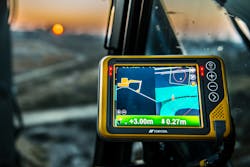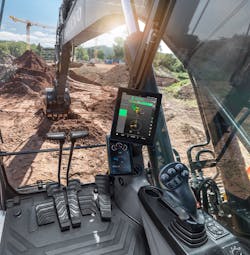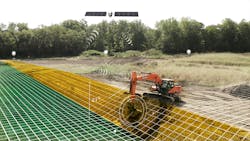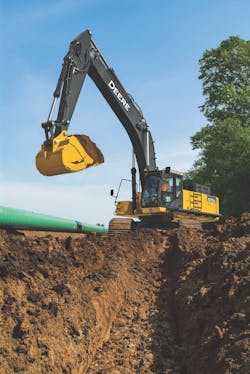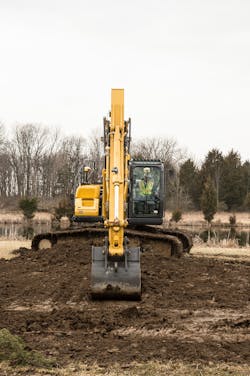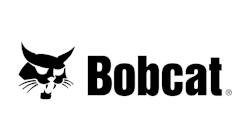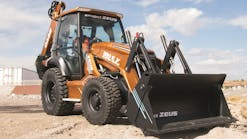Machine control adoption rates continue to rise as contractors realize the efficiencies and productivity their capabilities bring.
Machine control workflows improve the productivity, accuracy, and profitability of excavation projects, points out Fred Beachner, Topcon’s senior manager of product management for construction.
He adds that Topcon’s design of its user-friendly precise positioning on-board software has resulted in productivity improvements exceeding 30%.
Machine control has significantly increased efficiency and productivity by reducing the operator’s workload, notes Jonny Spendlove, excavator product marketing manager, John Deere Construction & Forestry.
“This has a compounding effect as contractors are still able to produce quality results with less experienced operators and more experienced operators can focus on more complicated tasks,” he says.
“Additionally, the accuracy being achieved by grade control solutions helps contractors reduce the number of passes required to complete a job, saving fuel, time, and wear and tear on machines.”
Cameron Clark, earthmoving industry director, Trimble Civil Construction, notes that machine control provides operators real-time information on where the grade is without the need for stakes and string lines—both above ground and underwater.
Machine control enables excavator operators to execute everything from a simple job to those based on complex 3D designs, “allowing excavators to be a surveying tool to measure points of interest or collect points for a topography where it is not practical or safe for a person to survey the points,” says Clark.
The key benefits of machine control can be summarized into three core elements, says Clark: better, cheaper, and faster.
The "better" factors include higher quality and accuracy.
“We have seen 100% more accuracy from lesser-skilled operators when leveraging Trimble Earthworks with Automatics and also 75% more accuracy with experienced operators,” says Clark.
Additionally, improved safety means fewer people are needed to work around the machine and with Augmented Reality, there is a greater awareness around the bucket, he adds.
The "cheaper" factors encompass fuel savings by getting to grade faster. Labor costs are reduced by giving operators needed information without having an employee in the trench or necessitating a grade checker or someone placing grade stakes or string lines, Clark says.
Less wear and tear means fewer machine hours and less rework, says Clark, adding material savings are derived from more accuracy.
“There’s no waiting on grade checkers or subcontractors,” he adds. “Operators have information in the cab.”
Increased productivity can be seen from operators who are far less skilled as well as experienced operators, says Clark, adding that some companies have noted 40% productivity gains even with experienced operators.
“Excavator operators can be confident that they are delivering a product to grade that matches a design file provided to them,” he adds.
Digging utility trenches at a uniform grade over short distances are among the most common applications for grade control systems, Kleingartner says.
“With a system installed on the excavator, the operator can accurately dig, place a pipe, and add fill material,” he says, adding that grade controls systems also are beneficial for excavating footings and producing a finished slope.
Machine or grade control systems enhance the efficiency and productivity of excavators by providing the technology to dig with confidence, notes Kleingartner.
“When the grade control system is installed on an excavator, operators have a wealth of information available to increase their proficiency,” he says. “The system provides real-time information to operators to ensure the project is being done correctly.
Large excavator machine control options abound on the market.
Caterpillar’s Next Generation CAT 395 and 374 excavators—the company’s largest excavators—feature indicate-only grade control as standard.
“These excavators are sitting on a bench and they’re top-loading articulated trucks,” notes Ryan Neal, Caterpillar’s product application specialist for large excavators. “They want to maintain a 10-foot bench. They can simply bench for a reference point from the top of their loading surface and if it's negative 10-foot bench down there, they're going to indicate a full 10-foot bench. It will keep them consistent throughout that entire cut.”
Inertial Measurement Units (IMU) are another feature as well as a bucket rotation sensor that tells the operator the precise position of the bucket.
“Being able to know that at all times is a great advantage to the operator. Sometimes depending on where you live and how much rain you have, you want to keep a little slope to it to keep the water away from where your working surface is,” says Neal. “You can put a percentage in there and maintain a positive or negative slope as well.”
The system also has the capability of identifying the material to break down the information even more. Throughout the job, the machine control system is tracking the total number of trucks, total tons moved, fuel efficiency, and total productivity.
“The point of Payload is to prevent over-loading and under-loading of the trucks as well as keep track of productivity for the entire day,” says Neal.
Information as to how many trucks were loaded, how many tons of earth moved, total percentage, and total day’s productivity can be pulled in three ways: viewing the monitor, downloading the information on USB, or viewing it on VisionLink's back-office data.
The system operates at plus or minus 3% accuracy, Neal says.
The capabilities of the excavators to address safety, efficiency, and productivity also pave the way for labor efficiencies.
“Somebody is potentially in the way,” points out Neal. “There are safety things to think about. But with machine control, this operator can now continue to work without having to stop. Knowing where the grade is at all times is huge because they're not second-guessing and there is no downtime checking the grades. As long as everything is measured like it's supposed to be, it works fantastic.”
Joysticks can be configured to accommodate operators’ preferences, he says.
Options include the Cat Grade with Advanced 2D, added to the TD520 display. It offers more capabilities for doing simple two-dimensional in-cab design such as stair-stepping the face of a working bench or matching the existing slopes of a ditch.
A step up from that is CAT Grade with 3D, which can be ordered direct from the factory or later as aftermarket, notes Neal.
It offers full dimensional 3D capabilities in designing that for which the job calls, such as contours, slopes, and underground pipe depth.
Doosan excavator end-users can add a grade control system to their excavator through a separate provider, says Kleingartner.
A technical support representative from the system’s supplier works with the contractor and the contractor’s dealership to ensure the grade control system is properly installed on the excavator and proper training is then provided, he adds.
Components of excavator grade control systems may include two receivers (masts) situated on the back of the excavator above the counterweight; sensors for the mainframe, broom tilt, arm tilt, and bucket line; optional angle tilt and rotational sensors, and an in-cab monitor.
JCB’s newest range of large excavators—the X-Series—features an improved hydraulics system designed to provide regeneration using the latest available Kawasaki pump and 15% larger Kayaba valve block for maximum efficiency.
Additionally, JCB’s X-Series machines have been tested through rigorous circumstances in a wide range of climates ranging from -22° to 130° degrees, notes Chris Lucas, product manager, excavators.
Among the X-Series enhancements: a 7-inch color screen monitor, a 15% larger cab over the previous model, high-back Grammer seat for operator comfort and reduced fatigue, an HVAC system designed to be 43% more efficient than the previous model, 67db in-cab, and soft double cushion hydraulic cab mounts for operator comfort.
Other enhancements include Bluetooth radio, isolations lever with an optional 2GO system, Command Plus interior, an improved dedicated lift mode with simplified quick hitch logic, a pressurized cab to reduce dust, and a standard rear camera for safety and increased visibility designed for greater efficiency.
The X-Series machines provide auto system fluid level checks upon startup, allowing the operator to start work immediately in contrast to the traditional 10- to 15-minute pre-shift walkarounds, he adds.
“The auto-idle feature allows the operator to set the required engine RPMs which stay revved as long as the hydraulics are being engaged,” says Lucas. “Once the hydraulics are paused, the engine will return to the idle state automatically, saving fuel and wear on machine parts.”
The excavator’s 15% larger Kayaba valve block and Kawasaki pump are designed to provide the maximum tear-out capability, limiting machine hesitation, he adds.
Also standard on the JCB excavator is customizable proportional controls to set their preference on speed and control of attachments, and power boost to enable nine seconds of full dedicated hydraulic power to the dig-end for tough conditions, immobilizer, a full cab monitor, and fully adjustable joysticks, pods, and switches that move with the seat for optimum comfort and ergonomics.
Additional standard features include LiveLink with geofencing capability, positive pressure cabs minimizing dust ingress, and up to 34% larger cooling packs and a 7% larger engine fan, allowing the machine to run cooler and cleaner.
Optional features include a GPS to assist with 2D and 3D systems, hydraulic quick hitch, Bluetooth radio, heated seats, and a side-view camera for 360 degrees of visibility.
Grade control technology is a gamechanger for contractors, Spendlove says.
“There are two main options for grade control technology on excavators and depending on the option, there are different capabilities,” he adds. “2D or 3D is an important decision to consider when reviewing options as well as the choice between grade guidance—manual grade control—or grade control, semi-autonomous grade control.”
John Deere offers Grade Guidance as a factory-integrated option on the 210G LC, 350G LC, and 470G LC machines and is designed to provide operators with the elevation and position of the bucket cutting edge concerning a target plane (2D) or design surface (3D), says Spendlove.
He points out that a full grade control system such as the John Deere SmartGrade integrated solution takes the technology to the next level.
“This solution provides automatic control of the boom and bucket, allowing accurate grades to be achieved fast with minimal effort. This system will be extremely useful for customers that might need a little extra help making finish passes at tight tolerances.”
John Deere offers two optional grade control solutions for its 210G LC, 350G LC, and 470G LC excavators.
“These models can be equipped with either 2D or 3D grade guidance system,” says Spendlove. “Equipped with a display in the operator station, the 2D option provides operators with the elevation and position of the bucket cutting edge with respect to a target plane.”
A second option, the John Deere SmartGrade excavator, features integrated grade control technology. With SmartGrade, sensors, wire harnesses, and controllers are fully integrated into the machine at the factory, and the complete system is supported by a John Deere dealer.
In Komatsu’s intelligent machine control lineup, its largest excavator is the PC490LCi-11 and with it being relatively new, its capabilities are still unfolding.
“Every day we learn something new that a contractor is doing with our excavators just because it's such an untouched technology,” says Brandon Rakers, Komatsu product specialist for intelligent machine control and smart construction.
Efficiencies and productivity gains began to manifest themselves as intelligent machine control that emerged from the traditional use of GPS and indicate-only systems.
Productivity gains don’t imply a “speeding up” of an excavator but rather focus on process improvement, Rakers points out.
It’s a solution many contractors are unaware they need, he adds.
Traditionally, contractors may have had a support GPS dozer serve as a “babysitter” to an excavator because the excavator operator had to wait for the dozer to push the material to final grade before it was loaded out, Rakers says.
With intelligent machine control on an excavator, the support dozer can now be moved into a production application somewhere else on the job site.
Previously, two machines were part of a mass excavation process, but an intelligent machine control excavator can now do the work of both, Rakers adds.
This cuts down on the cost per yard and minimizes the number of times a contractor moves dirt. The key is not eliminating the support dozer but improving the process by putting it in a production application, he says.
"It changes the way we do things, even when we look at utility applications," he adds. "You eliminate the one guy down in the hole who could be hooking up a pipe instead of waiting and giving the grade. It helps lower the cost per linear foot."
A contractor can be taught how to use it and be up and running in 10 minutes, followed by ongoing education on its many features, Rakers says of its user-friendliness; adding intelligent machine control to an excavator has taken what used to be done manually and automated it for the operator.
“One of the key things we've observed is that the learning curve for a novice operator has been greatly reduced to get them proficient, to get them excavating to grade accurately using our intelligent machine control,” says Andrew Earing Product Manager of mid-size excavators.
“Our senior operators have become more comfortable,” he adds. “They don't have to focus quite as hard on making sure they're at grade and maintaining grade because the machine is doing that for them. We’ve found they’re much more comfortable. With the shortages we're seeing in skilled trades in our industry, that’s a great thing because it’s keeping them in the seat longer.”
A favored feature is minimum distance.
"The machine automatically selects what side of the bucket is closest to the designed surface," says Rakers. "This is something an operator would already know and do because he can see that. He knows that if he wants to pull grade with the left side, he's going to be looking at the left side of the bucket. Now the machine does it for the operator, helping reduce over-excavation.”
Of Komatsu’s LCI excavator, Rakers notes that “we see that this solution is something that benefits the contractors and it's just one component of our Smart Construction job site" with Komatsu’s offering fitting into an overall industry trend.
Komatsu "harmony"—a consistent and orderly arrangement of parts—is designed into the manufacturing process to integrate the technology of the display, ICT controller, and all of the sensors working in conjunction with Komatsu-built logic for a better end-user product, says Rakers.
Beachner says applications of Topcon excavator systems continue to expand to include jobs such as digging a utility trench, loading trucks, or grading various surface types to help keep the buckets on grade anywhere on the job site.
Topcon’s portfolio of machine control solutions ranges from an entry-level 2D and 3D systems to its flagship Automatic Excavator option.
“When contractors are ready to upgrade their machines, the modular hardware makes it easy and cost-effective,” says Beachner.
For instance, the company’s X-53x Indicate system provides real-time, dynamic on-screen bucket location and design views. It allows operators to cut grade faster and more accurately as well as create, cut, and check complex designs from the cab, and it increases safety by removing the grade checker from the trench.
Matthew McLean, product manager, excavators, Volvo CE, notes the Volvo excavator machine control system Dig Assist is available on all nine of the company’s large Volvo excavator models.
“For most owners, fuel consumption is the first cost of operating an excavator,” says McLean. “Built with nine different settings within four work modes, Volvo excavators allow operators to dial in the exact amount of power and control needed for the task at hand while burning as little fuel as possible.”
The auto-idle feature on Volvo excavators is designed to reduce fuel consumption by automatically switching the engine to the high idle setting after a set number of seconds of inactivity.
Productivity features like Dig Assist, which is operated via the 10-inch, in-cab Volvo Co-Pilot tablet, help operators increase their productivity level, says McLean.
“This machine control system shows operators in real-time how to level sites, dig trenches, grade slopes, and take quick measurements or even create complex multidimensional site profiles,” he adds.
Volvo Active Control is a recently released Dig Assist feature available on the company’s North American EC220E, EC250E, and EC300E crawler excavators.
The system is designed to guide the operator through the functions to automate the digging process. After job parameters are entered and it’s launched via a button, the excavator automatically adjusts the boom and bucket movements to make precise cuts following the desired shape and delivering the right angle of grade.
The speed and precision of Volvo Active Control cut grading time by 45% compared to conventional grading, says McLean.
Dig Assist is essentially a collection of excavator machine control apps displayed and utilized on the Volvo Co-Pilot display.
Last year, Volvo made Dig Assist Start—the basic package—standard on the company’s new EC220E to EC480E eight crawler excavator models, designed for optimal operator productivity and job efficiency as well as durability with reinforced undercarriage components and high-quality welds.
McLean points out that with the upgrade to the In-Field Design app, operators get access to satellite location technology and several performance-enhancing features.
3D is a good option for complex or larger projects, says McLean.
Trimble Earthworks Grade Control Platform integrated with the Trimble LOADRITE Payload Management system optimizes loadout without overloading trucks, says Clark.
“Augmented Reality with Trimble Earthworks enables the operators to see the digital design/model overlaid on the real site to help interpret and understand the job at hand,” he adds.
Machine control plays a pivotal role in increasing the productivity of lesser-skilled and experienced operators, says Clark.
“Incorporating with avoidance zones, you can increase safety and inform operators of areas that they should not be in,” he adds.
Trimble Earthworks Infield Design applications such as alignments and sections or pad and slope creation give tools to operators to complete work and adapt and leverage machine control and guidance for areas that do not have a design, or a design change is needed, says Clark.
Trimble Earthworks Automatics is designed to control the bucket, keep it on grade, and automatically tilt the bucket to stay on grade.
The systems collect data that can be fed back to the office for productivity and volume calculations. It offers the ability to remotely view a machine’s progress and productivity, including being able to remotely see what the operator sees to assist the operators and understand what they are doing, says Clark.
Applications include mass excavation, highway construction, subdivision development, and landscaping, among others.
“Once the Trimble Ready excavator is in the field, the Trimble Earthworks electronic components are more quickly and easily installed by the local SITECH dealer,” says Clark.
“Some functions—be it from factory-installed systems or aftermarket upgrades on factory systems—are capable of more, leveraging functionality that the machine enables or supports,” says Clark.
Machine control adoption rates vary by region, says Clark.
“The Nordic countries and Europe are heavily adopted and are the leading users of excavators and grade control,” he points out.
“Entry-level factory-based solutions have also helped drive adoption of grade control, as well as programs like Trimble Ready, which make it very easy for dealers in the aftermarket to add on technology to machines.”
Adoption rates are a “fast-moving train,” notes Neal, adding that only four years ago, he had only noticed a few excavators with grade control on them at Trimble Dimensions User Conferences in contrast to two years ago, where there was a significant number of excavators equipped with grade control.
Neal says there are several driving factors for the uptick, one being a tight economy calling for equipment to perform more efficiently.
“The 3D world may cost an initial chunk of change, but once they see the capabilities of it, they say they wished they’d adopted it years ago. It doesn't matter if they're moving bulk earth or doing sewer work, they take advantage of the technologies given to them and are so amazed they don’t want to go back.”
The benefits then provide a relatively quick return on investment, Neal adds.
McLean says the market is transitioning from the early adopters of machine control into the growth phase.
“There are several companies offering machine control systems and most OEMs have announced they are working on one or more of them,” he says, adding his company used to field one or two requests a year to making weekly inquiries.
While manufacturers are answering the call to equip their excavators to help contractors benefit from machine control features, a time is coming when today’s technologies will be in the rear-view mirror as even more advanced capabilities drive the industry forward.
Case in point: in 2019, Doosan Infracore announced its Concept-X system, a comprehensive control solution for construction sites.
Concept-X—expected to be commercialized by 2025—is designed to be used to survey worksite topography via 3D drone scanning, establish operational plans based on the topographical data, and operate construction equipment—including excavators—without human intervention.
“Concept-X realizes the construction site of the future by having difficult construction work performed solely by equipment,” notes Kleingartner.
